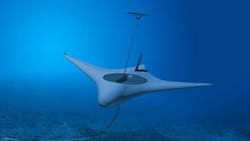DARPA Manta Ray project seeks to develop long-range unmanned submarines able to operate for months at a time
WASHINGTON – In the near future, the U.S. Defense Advanced Research Projects Agency (DARPA) in Arlington, Va., wants to deploy unmanned underwater vehicles (UUVs) that can take-on months-long missions without any in-person human logistical support or maintenance. Popular Science reports. Continue reading original article
The Military & Aerospace Electronics take:
1 April 2020 -- DARPA awarded contracts in February to three companies that will help develop the unmanned submarines: Lockheed Martin Corp., Northrop Grumman Corp., and Navatek LLC. A fourth company, Metron Inc., is working on solutions specific to undersea energy harvesting techniques that will allow the autonomous subs to operate seamlessly at great depths.
Their work is part of DARPA's Manta Ray program, which will advance technology for future long-range unmanned undersea vehicles. The name relates to an artist's mockup of one of these potential subs, which resembles a Manta Ray. With little human support required, DARPA hopes these vessels will eventually become another arrow in combatant commanders' quivers.
"The Manta Ray program aims to increase at-sea operational capacity and capabilities for the combatant commander while minimizing disruptions to current operations by remaining independent of crewed vessels and ports once deployed," says Navy Cmdr. Kyle Woerner, the DARPA Manta Ray program manager. "If successful, this new class of UUVs would allow operational flexibility and relief of workload for both traditional host ships and servicing ports."
Related: DARPA asks industry for large unmanned undersea vehicle advanced payload delivery system
Related: DARPA considers unmanned submersible mothership designed to deploy UAVs and UUVs
John Keller, chief editor
Military & Aerospace Electronics

